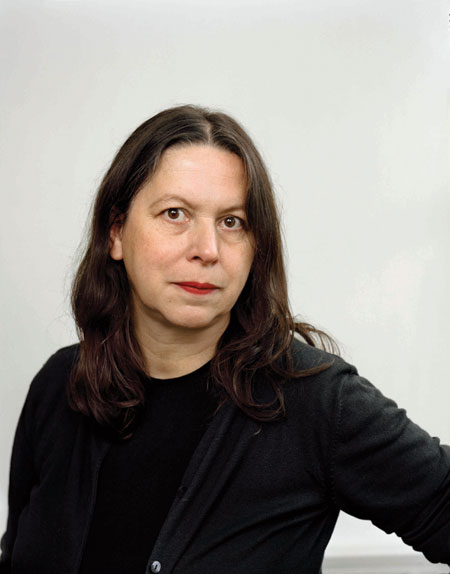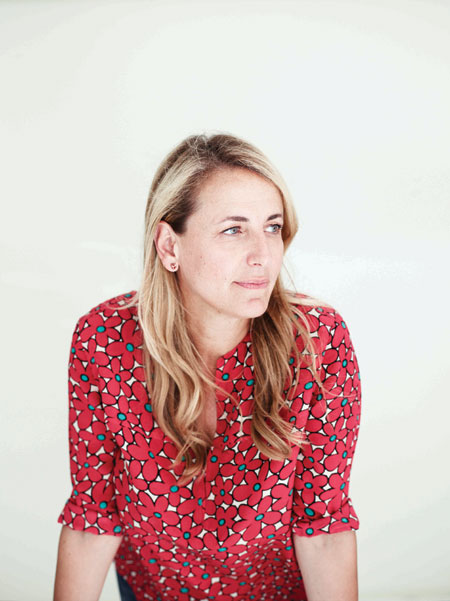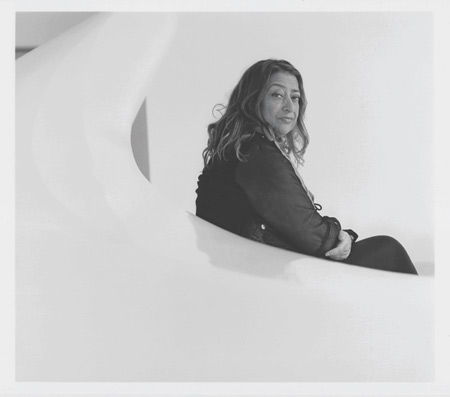- Some are instantly recognisable public figures with headline-holding power, while others exert their influence through groundbreaking work in their specialist fields, but all are revered by their colleagues and peers and have had a profound impact on their professions. On the following pages you’ll discover more about some of the women who have changed how we think about the buildings we use, the exhibitions we visit, the books we read and the furniture we live with
Words Alyn Griffiths
Paola Antonelli
Curator
.
Paola Antonelli believes that serendipity and her upbringing in design-obsessed Milan were the key factors in determining her path in life – a path that has led her to the position of Senior Curator for Architecture and Design at New York’s Museum of Modern Art (MoMA). “I was lucky,” she says. “I became involved in the design industry quite organically because it’s normal fare in Milan.”Luck may have played a role, but after studying architecture in Milan it was a dedication to seeking out innovative ideas and presenting them in engaging ways that secured her editorial roles at prestigious publications Domus and Abitare before she joined MoMA in 1994. She has since curated a string of acclaimed exhibitions exploring the role of design in society and recently founded a research and design department at MoMA that will “study new ways for the museum to be even more influential and its mission more incisive, harnessing not only technology and innovation, but also the extraordinary resource that few other institutions can flaunt: a direct dialogue with the audience and with artists.”
Antonelli believes strongly in the transformative potential of culture and creativity and feels that museums can play a key role in demonstrating this during troubled times. “Culture is an engine for a growth that’s slower, but more constant, reliable, positive and humanistic. That’s what I’m hoping that museums and the research and design of society can prove.”
Paola is Senior Curator, Department of Architecture and Design at the Museum of Modern Art in New York, USA
Photography Marton Perlaki


Irma Boom
Graphic Designer
.
The word that graphic designer Irma Boom uses most when talking about her work is “specific”, and there is certainly nothing conventional or standardised about the book designs that have brought her acclaim and recognition throughout a career that began when her first groundbreaking book was published in 1988.Boom says she went to art school to become a painter, but it was only when she wandered into a lecture about book design that she began to feel she belonged. The 300 or so books that she has designed since have consistently combined a painstaking approach to research (one book for Dutch institution SHV Holdings took her five years) with a sculptural sensibility, resulting in objects that are tailored to the specific requirements of their contents. These experimental books deliberately defy many of the established rules governing typography, layout and binding and were a shock to her more conservative peers when Boom started out. “If I read now what people wrote about those early books I still get goosebumps,” she remembers. “It’s amazing that I survived!”
As well as a steady stream of book commissions, Boom’s tiny team in Amsterdam also works on identity overhauls and large-scale one-off commissions. She has been a lecturer at Yale university since 1992, where her students gain skills that are transferable to many different media, including online. But she insists that the specificity and tactility of printed books still holds great value: “Making books has been part of culture since
1455 and we still haven’t reached the limit of
what’s possible!”Irma is a Dutch graphic designer with a studio in Amsterdam, The Netherlands
Photography Dana Lixenberg

Patricia Urquiola
Product Designer
.
Around the stands at Milan’s annual furniture fair, you’re likely to come across several examples of the work of Spanish-born, Milan-based designer Patricia Urquiola, who is a go-to-girl for manufacturers looking to add personality to their product range. She counts Moroso, Molteni, B&B Italia, Kartell, Driade and Foscarini among her clients and is known for her eclectic approach, which results in designs with diverse formal and cultural references.Urquiola says she is lucky that the majority of her clients have allowed her the freedom to explore new creative opportunities, rather than pigeonholing her with a particular style: “I like a definition from Eduardo de Filippo: ‘Who’s in search of a style finds death, who’s in search of life finds a style.’”
Urquiola studied architecture in Madrid before moving to Italy to complete her education at the Politecnico di Milano, where she was mentored by Achille Castiglioni. She subsequently worked with Vico Magistretti at design brand De Padova before setting up a studio with some friends. She remembers that her greatest challenge was to “believe in myself as an author and make the others believe too,” but says that she now takes pleasure in the unpredictability of the creative process, describing her job as “an ongoing experiment.”
It seems the experiment is working, and Urquiola is now regarded as one of the most sought after and influential designers of her generation.
Patricia is a Spanish product and furniture designer based in Milan, Italy
Photography Danilo Scarpati

Patrizia Moroso
Creative Director
.
As creative director of the company, Moroso, founded by her parents in 1952, Patrizia has spent her career commissioning and collaborating with some of the world’s leading designers, including Toshiyuki Kita, Ron Arad, Marc Newson and Patricia Urquiola. Moroso first got involved when the company was struggling in the turbulent financial climate of the mid 1980s and helped to transform a small family business into one of Italy’s foremost furniture manufacturers. She was raised around the family’s factory, which helped her develop an instinctive affinity with the needs of the designers she works with.“I have always been interested in art and design because I had been brought up around it,” she explains. “In the beginning it was a natural progression. I was not obliged, I was happy to do it because it was very familiar and very easy.”.
.
By allowing designers freedom to experiment and explore creative solutions, she has overseen the evolution of a portfolio of characterful products that merge expressive forms and material applications with finely crafted detailing.While she believes in a “special female touch”, she asserts that her focus is on inspirational ideas and talented designers with a personal vision, although she adds: “Creativity is something that belongs naturally to a woman. We create life, that is the best thing anyone can do!”
Patrizia is creative director at furniture brand Moroso, which is based in Udine, Italy
Photography Danilo Scarpati
Mirkku Kullberg
Creative Director
.
Having studied marketing and administration, Mirkku Kullberg helped transform the fortunes of several Finnish fashion brands before taking on the role of CEO at iconic furniture company Artek in 2005. “I’m basically a restructurer,” explains the Finn, who divides her time between homes in Berlin and Helsinki.After learning about the company’s heritage as a respected manufacturer of innovative products, Kullberg made a bold decision to return to traditional values, eschewing the high turnover, fashion-led approach favoured by many competitors and buying back iconic products designed by Artek founder Alvar Aalto in the 1920s. “I think design should be functional; it should have a good form and it should serve the consumer’s needs rather than their desires,” she explains.
Kullberg established an in-house creative team that develops long-term research projects with manufacturers and is collaborating with “two international designers who will release new products in late 2013”, but in the meantime says she is happy to focus on extending Artek’s current product ranges. This slow but steady approach has created a solid foundation that Kullberg is keen to build on: “This is a company with a great legacy
and a great future and I believe we can really make
a difference.”Mirkku is the chief executive officer at furniture company Artek in Helsinki, Finland
Photography Stefan Heinrichs

Zaha Hadid
Architect
.
Last year, multi-award winning architect Zaha Hadid became a Dame Commander of the Order of the British Empire (DBE), an award that she describes as “humbling”, adding that the honour, “represents full recognition of what started 30 years ago as my projections of a possible future architecture.”Hadid grew up in Iraq and travelled to Europe every summer with her parents, where her father would ensure she “visited every important building in sight!” She studied mathematics in Beirut before moving to London, and enrolling at the Architectural Association. There she encountered inspirational tutors including Elia Zenghelis and Rem Koolhaas, and she remembers it as a place brimming with creative energy: “There was such a buzz in the school at the time. Everyone was on the brink of doing something new.”
Following a brief spell with Koolhaas’s Office for Metropolitan Architecture, Hadid began to pursue her own architectural vision, designing buildings with a fluid spatiality that many clients and critics initially struggled to accept. Determination and passion helped her overcome these early difficulties, and many others she has had to confront in her career. “Architecture is a very tough profession,” she says. “Every architect you talk to, no matter how successful they are, man or woman, has it very difficult. Perhaps it was my flamboyance rather than being a woman that gave me such determination to succeed, but I have always been extremely determined.”
 Hadid’s office is currently involved in around 40 projects, from a cultural centre in Azerbaijan to a museum in America, and after years of tribulation followed by success, her passion for the mystery and excitement of the creative process remains unfaltering. “You cannot predict everything, and with each new project I always feel a real sense of discovery; it’s a truly original and uplifting experience.”
Hadid’s office is currently involved in around 40 projects, from a cultural centre in Azerbaijan to a museum in America, and after years of tribulation followed by success, her passion for the mystery and excitement of the creative process remains unfaltering. “You cannot predict everything, and with each new project I always feel a real sense of discovery; it’s a truly original and uplifting experience.”Dame Zaha Hadid is an Iraqi-British architect and designer with studios in London, England and Hamburg, Germany
Photography Michael HemyLeaders of Industry appears in Port issue 7: read an exclusive in-depth interview with Dame Zaha Hadid here
Subscribe to Port Magazine annually and receive each issue to your door.
Get PORT in print



